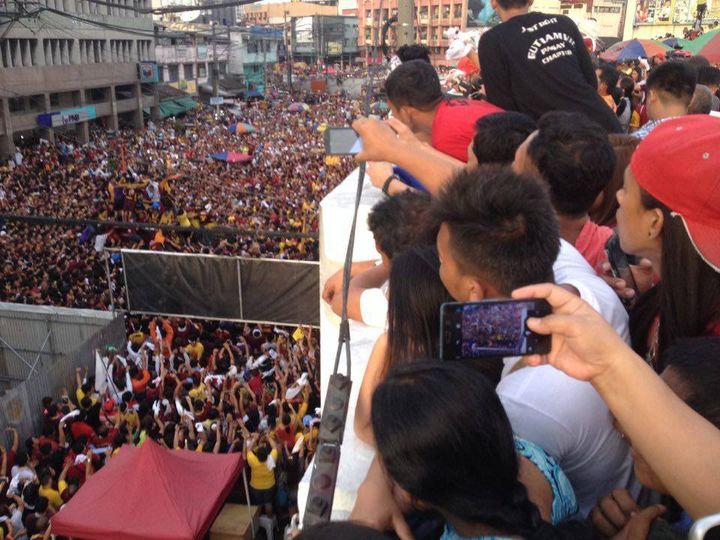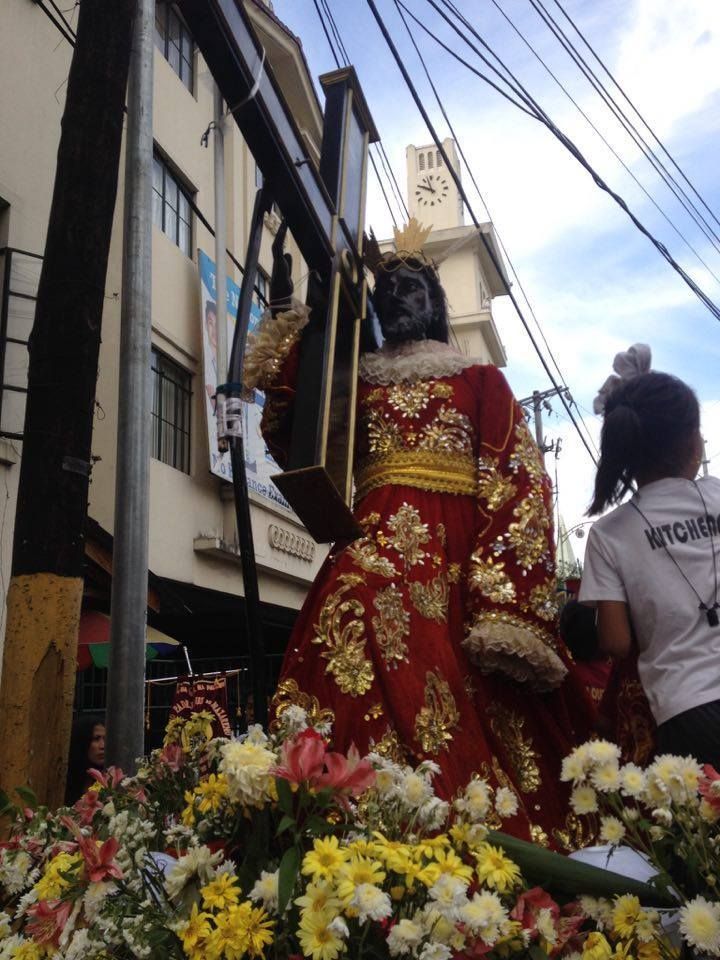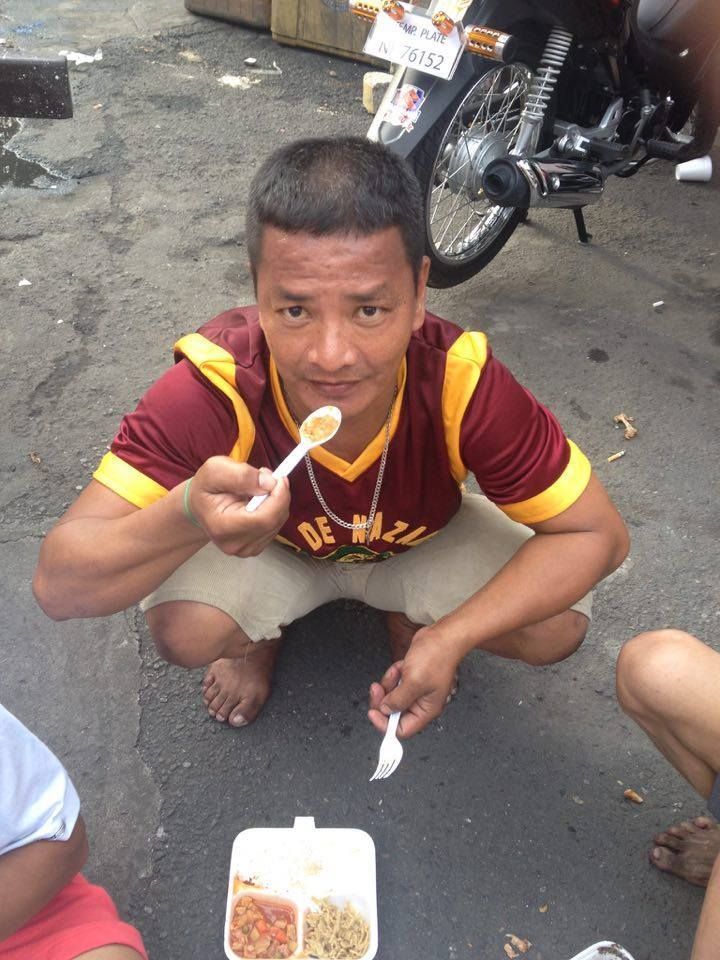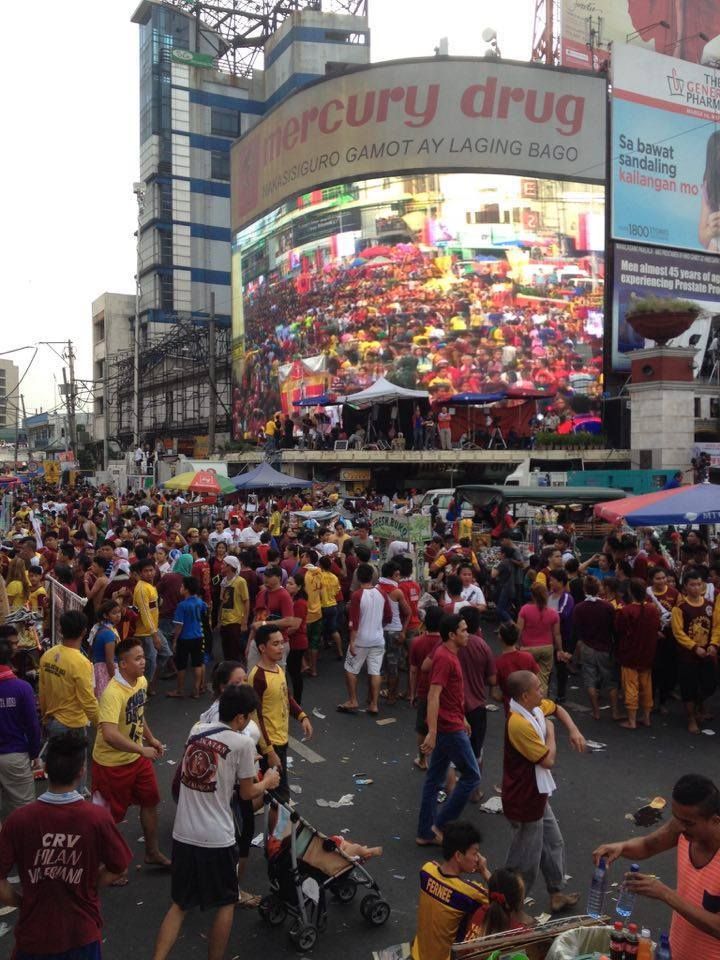
A glimpse of the Black Nazarene
Two weeks ago, I found myself in a jeepney on the way to the Black Nazarene in Quiapo. Across me two elderly women looked out the window, holding large, white handkerchiefs. The older of the two draped the translucent cloth over her somber face, much like a wedding veil, to shield it from the blinding sunlight. They were Nazarene devotees.
Beside them, what I presumed to be a mother and son, bickered over the fastest route to Quiapo Church. The kid was in the middle of a hissy fit, frantically showing the Google-maps coordinates of his phone to the now-hushed woman. He threatened to leave her behind to get there more quickly. The mother turned red, visibly humiliated by it all.
We were dropped off at the Ayala bridge along J. Nepomuceno street. All roads leading to the site of the Nazareno were blocked by the Manila City government. For safety and decongestion purposes, according to the jeepney driver. It was quite a walk from here to Quiapo Church but I didn't mind. It gave me the chance to join the procession, even as a mere spectator.


Imitation Black Nazarene
I was greeted by a horde of devotees marching along the street in full regalia; their matching purple and gold shirts gleaming against the dour gray of the nearby gas station. They carried intricately designed banners, bearing the name of their municipality while chanting "ole! ole! ole! ole!" in perfect unison — like the rowdy cheers of football fans. Their jaunty gait and festive mood made it feel more like a parade than a procession until I saw their feet -- bare and calloused, the mark of their devotion to Christ. The dust had gathered and stained their soles coal black, almost as dark as the replica Nazareno they dragged along.
Along J. Nepomuceno the other devotees sat on the sidewalk in throngs, exhausted from the day's trek. Across them were endless stalls of street food, filling the air with the smell of grease and grilled meat (fries with cheese powder, fatty barbecue, siomai at ten pesos for three pieces). It was inviting and nauseating at the same time.

A line of Black Nazarene imitations passed by, the packed streets allowing them to inch forward only one at a time. A group of children were perched on top of the elevated peana of one them. They caught and threw back towels lobbed by devotees after rubbing them on the figure of Jesus (as believers would have it, touching the Black Nazarene by hand or any item can cure illnesses and grant miracles). Since the towels were only rubbed on replicas, I could only presume it was a warm-up or sorts for the real thing. Or more likely, it was all just part of good-old fun -- a prevalent mood in the streets.
I stumbled upon one group of devotees from Sampaloc where I lived with my family too many years ago. I follow them closely behind out of some vague sense of familiarity. A few minutes later, the group stopped at one of the side streets. They took out packed lunches and bought sodas in the nearby sari-sari store. They told jokes and shared their meals in keeping with the fiesta vibe of the event. To my left, an old man danced cha cha alone to the beat of Mambo No. 5 blaring from the radio of the karenderia. To my right, two-middle aged men tried to best each other in a drinking contest. The bottle of Emeperador Light more than half-way empty on their table.
I approached the devotees to ask if I could interview one of them. They pointed me to Mr. Cristobal, an MMDA flood agent that had been partaking in the Traslacion for over thirty years. I asked him why he kept on joining. He said it was for the miracles -- lottery wins to be exact. He won a few thousand pesos in 2002 and 2006, something he chalked up to divine intervention. Beyond the lottery, I asked him what other miracles he's received in the past three decades. "Tatlong beses pa naman kami kumakain ng pamilya ko araw-araw," (My family still eats three meals a day) he said with a smile.

Mr. Cristobal
Mr. Cristobal started his annual pledge of devotion at seven when he was dragged by his mother, herself a devotee, to his first procession. He noted that it was also his way of paying tribute to her, although he admitted that he didn't know why his mother became a devotee. When I asked if I could quote him and take his photo for my blog, he turned to his friends and exclaimed "sisikat na 'ko!" (I’m going to be famous). He then lifted a spoonful afritada and rice before posing for the picture. That was his second meal of the day.

Jumbotron at Plaza Miranda outside Quiapo Church displaying the packed street
Quiapo Church was teeming with people, barefoot men and women welcomed in hallowed ground. The mass was about to end and people were singing along to Lucio San Pedro's Nuestro Padre Jesus Nazareno, screaming "viva!" in the silence in between notes. Beside me, a tall man dressed in a garish mix of a hot pink shirt and faded ripped jeans, raised his white towel high above his bowed head and wept. Unsure of the procession's winding route at that time, I thought I could find the Black Nazarene somewhere near the Church itself. To my disappointment, the churchgoers said it was far away and surrounded by a sea of frenzied devotees. My best chance would be to go up Quiapo bridge and get a glimpse of the Nazareno from there.
The climb up was steep. The barricade lining the entire bridge was occupied by media men, spectators, and devotees alike, jockeying for a better view. I had to find a prime position from which I could watch the incoming Black Nazarene. This meant walking further up the bridge with gravity mercilessly bearing down on me with each step. I endured and managed to sneak into an empty spot behind a group of shorter folks (I, nonetheless, had to tiptoe the entire time). Zaccheus, the sinner, climbing up a concrete tree to see the savior himself.
The sight was too far away from the street but it would have to do. Across me, situated on the second floor of low-level building, two military men looked on. Beside them, a civilian was balancing on top of the narrow edge of a pillar. Onlookers yelled for him to stay on the roof instead as it was a lot safer. He didn't listen.
Right below, the tens of thousands of devotees pushed against each other in a religious mosh pit. It looked almost violent from where I was standing but the uniformed men didn't seem alarmed. "Ayon na! Hinihila na!” (There it is! They’re pulling it) the lady beside me announced. The Black Nazarene came into view, mounted by countless devotees hoping to get a touch. They wore the traditional procession colors of yellow and maroon, odd looking bees swarming towards the Queen in a fierce display of loyalty as she leaves the colony. The frenzy was overwhelming enough to be felt from up the bridge. A blur of white towels and black phones were raised to capture and revel in the moment, medieval faith and millennial technology in shared devotion.

I was caught in another world. Faith at its purest, one could argue. Praxis before contemplation. I've long forgotten this mass-base of Christianity. The Black Nazarene exemplifies the brand of religion most Filipinos still subscribe to. It was simultaneously grand and humble, a martyr-like devotion hinged on tradition more than scripture. The type of worship introduced by the Spaniards centuries ago. The Traslacion predates the country's declaration of independence by nearly three hundred years.; and, in an age of supposed secularism, it shows no sign of dwindling.
The crowd dispersed as they lost sight of the Nazareno. I, myself, went down the other side of the bridge going to Central LRT station, homebound. On the way I passed by a blind man with a huge cash box at his feet that read "Donation For the Blind. Thank you. God Bless!" He played a familiar tune on his electric guitar, a love song made popular in the ‘70s, about a lover’s undying devotion throughout the years. In a hauntingly beautiful voice he sang." Ang nakalipas ay ibabalik natin. Ipapaalala ko sa 'yo. Ang aking pangako na ang pag-ibig ko'y laging sa'yo. Kahit maputi na ang buhok ko.” (We shall rekindle our old love and reminisce about the past. I promise that my love will forever be yours. Even when my hair grows white).